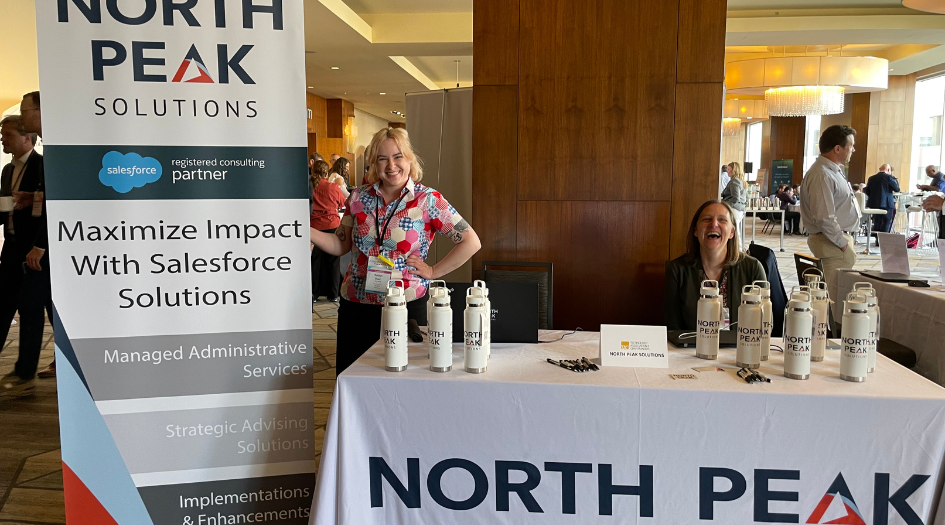
Whether you’re planning a new Salesforce implementation or have an existing instance that you’re building on or redeveloping, establishing clear, measurable goals and a realistic timeline at the outset will help you stay on budget and ensure that the final solution meets critical requirements and supports the way your team works. Here are a few tips to help ensure your Salesforce implementation is a success, from start to finish.
Clarify Your Goals for the New Implementation
Undertaking a Salesforce implementation is hard work, so you should be crystal clear on your goals. Consider the following questions as you’re getting started on your implementation plan.
- How will the database help support your mission and workflow?
- What challenges are you trying to solve?
- Why will a Salesforce implementation help you achieve these goals?
- Do you have the capacity to manage the database in-house, or will you need to bring in an outside Managed Services consultant to fill a staffing gap?
Using your end goals as a guide ensures you always have a solid plan to refer back to when questions or issues arise during the implementation. Getting clear on these goals also helps you set a realistic timeline for the project.
Don’t Skimp on Requirements
The discovery phase of any implementation is THE key to ensuring your project is a successful one. In this phase, you will work with your stakeholders to define goals, challenges, and opportunities, and ultimately develop in-depth user stories for your organization. This is also the time to build buy-in for the Salesforce implementation. People are busy, and if staff are only somewhat engaged in the discovery, it will be harder for them to connect the implementation to the organization’s mission and processes. Help them understand how this will impact their day-to-day activities and how their work may evolve as a result. A robust discovery should generate:
- Alignment of goals for the project
- User stories which will form the blueprint of the build
- A realistic timeline
- An implementation budget
- A general overview of data migration requirements
- Expectations for stakeholders, including training
- A roadmap: typically not every requirement will be prioritized for a first implementation. These requirements get added to a roadmap that can be addressed in future enhancements
Not All That Glitters is Gold
Salesforce is an incredibly flexible CRM database that can be customized to do virtually anything you can think of. Salesforce itself boasts a whole array of products, from marketing tools to cutting edge AI features. There is also a universe of third-party apps and packages that can be installed on top of Salesforce to expand functionality. But- just because these options exist, it doesn’t mean that you should, or need, to use them. When the end goal of an implementation is unclear or when a robust discovery has not been completed, we find that it’s more likely organizations will be upsold or overbuy tools that either do not meet their requirements, are too expensive, or are too complex.
An implementation consultant that has your best interests in mind (ie, they’re doing what’s right for you, their client, and not simply following through on what the software vendor wants to sell you) will be able to help you determine which options are essential tools for your team, and which ones are unnecessary, or can be added on at a later point in time.
Understand and Build Staff Capacity
Salseforce is not a one-and-done tool. The benefits of this CRM is its flexibility to evolve as your organizational needs or workflows change. Establishing how your organization manages the implementation and continues to improve upon it will be crucial for the long-term success of the database as a business intelligence tool.
When it comes to regular maintenance of the database, you’ll want to ensure there is someone in place (either an in-house Salesforce Admin or an outsourced Managed Services consultant) to ensure data quality, troubleshoot issues as they arise, and engage in staff training. If that person is in-house staff, it’s crucial to ensure their skills are up to the challenge, and they have the capacity to really take on the job. It’s common for organizations to add the role of Salesforce Admin to an existing position, and sometimes that works out. More often though, the Admin role ends up taking more time than expected, or is deprioritized when staff capacity is pulled in too many directions. Whenever possible, we suggest making the Admin role its own position, or hire a Managed Services consultant to fill the gap.
Next Steps
Implementing Salesforce is a big undertaking that can generate positive, long lasting results for your organization. From improved reporting to streamlined program management, Salesforce’s flexibility is both its strong suit and its challenge.
When teams are clear on their needs and have solid end goals to refer back to, the final solution will become an essential business intelligence tool. Contact us today to learn more about implementing Salesforce for your nonprofit or foundation.
About North Peak
North Peak provides Salesforce-based services for nonprofits, foundations and the affordable housing sector who want to utilize the power of high-functioning CRM and GMS platforms. We achieve this through a holistic set of services, tailored to the needs of our clients.
Blog: Salesforce + HomeKeeper Improves Service Delivery for Detroit Housing Network
Implementation of Salesforce + Homekeeper Improves Program and Service Delivery for Detroit Housing Network.
Schedule a Free Consultation
If you’re considering implementing Salesforce or need help with Managed Administrative Services, or simply have questions about how to transform your organization’s data practices, we’d love to talk! Contact us for a free 30 minute call.



